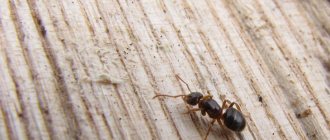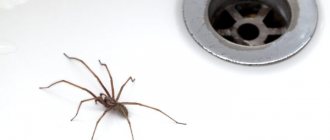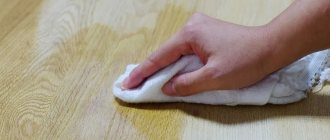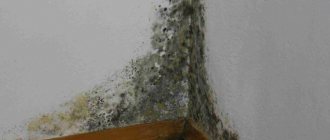06.11.2016
Spiders appear in almost every apartment from time to time. People's attitude towards these living beings is ambiguous: some do not like them and try to eliminate them, others, blaming folk superstitions, leave them alone. In order not to torment yourself with doubts about what to do with new neighbors, you need to know whether they are dangerous or, on the contrary, beneficial and how to prevent their appearance in the apartment.
- What species live in the apartment
- Reasons for appearing in the apartment
- Dangerous or not
Why do spiders prefer to live in houses and apartments?
The most suitable conditions for these arthropods are damp, dark, cool places with a lot of insects. The ideal location that fits this description is a basement or cellar. However, if there are a lot of spiders in the apartment, then there are reasons for this:
- Humidity. Problems with plumbing or drainage, leaking faucets and pipes create favorable conditions for spiders. They live under the bathtub, behind the toilet and pipes;
- Purity. Clean your apartment regularly. When cleaning, suspended cobwebs are brushed or vacuumed away from corners. With regular such treatment, spiders do not have time to weave new webs;
- Insects. All animals must eat. If there are a lot of small pests in the house, it will certainly attract unwanted tenants in the form of spiders.
- Safety. Houses and apartments are less dangerous for spiders than open spaces. So if spiders appear in your house, it means that the conditions are favorable for them.
Important fact! Spiders easily adapt to their environment. A few years ago, scientists discovered a new species even in the icy waters of Antarctica.
Benefit or harm
Spiders help fight harmful insects in the house, but at the same time, they create grounds for fear and irritability among household members at the sight of multi-legged creatures scurrying around. Cobwebs in corners and on walls, behind cabinets, under bathrooms and in hard-to-reach places create soil for dust to settle, the remains of eaten insects accumulate, and an unpleasant odor appears.
On the one hand, spiders are housekeepers in the presence of a large number of synanthropic and parasitic insects, but pests must be combated not by breeding arthropods, but by keeping the house clean and tidy, and the absence of favorable conditions for the habitat of any arachnids and mites. Spiders should live away from humans - this principle must be followed.
On a note! Despite the fact that harmless, non-poisonous spiders most often weave webs in apartments and private houses, dangerous specimens are also occasionally found. In addition, fear and severe stress are guaranteed to almost everyone who sees a large spider on the wall or on a thin “fishing line” in the middle of the room right before their eyes. When living in a house with hypertension, patients with nervous disorders, cardiovascular diseases, or impressionable individuals, it is necessary to restore order even more actively in order to avoid encounters with insects that terrify many people.
Types of spiders
There are three main groups of spiders.
Araneomorphic
The most common species are 43,834 arthropod species. Originally inhabited by Latin America, from where they have spread throughout the world since the 1970s. They have adapted to life next to humans.
Mygalomorphic
Includes 2875 species of spiders.
arthroplasty
The least common class, includes only 97 species of spiders.
Mediterranean recluse spiders, distinguished by their reddish-brown or yellowish coloration, live in the southern latitudes of Europe and Russia. The degree of threat from the venom of this arthropod species requires additional study.
Are spiders in the house good or bad?
It is impossible to say for sure whether the presence of spiders in an apartment is a good or bad sign. On the one hand, it is beneficial for these arthropods to destroy dangerous insects. Most of those living in the apartment do not pose a threat to people. These are small representatives of a species of arthropod that feed on flies. They fear us more than we fear them. Larger spiders prefer to weave their webs outside houses, under roofs, and in tree branches. They need more serious prey than flies, fleas and mosquitoes. Such insects can enter the apartment only occasionally.
Note! Spiders from the apartment try to hide when they see people. They do not attack or bite. They are more afraid of humans than we are of them and are absolutely harmless to people!
On the other hand, arachnophobia (fear of spiders) is one of the most common phobias among people. This disease affects almost 7% of the world's population. According to statistics, we are more afraid of spiders than of cars, planes and weapons. Although, again, according to statistics, spiders are much less dangerous and cause illness or death much less often.
For people who are afraid of spiders, living in the same apartment with them is inconvenient. And if there are many such neighbors, it will be unpleasant for everyone.
Favorite Habitats
Spiders in the house prefer to settle in secluded, safe corners.
- Often arthropods can be seen between wooden window frames, under window sills, behind radiators.
- On the balcony, especially if it is used as a place to store necessary and not so necessary things.
- A spider can live in the bathroom - in inaccessible crevices behind pipes and plumbing.
- Dark basements, closets, and attics are the usual habitat of spiders.
- Some spiders prefer to place catching nets on indoor plants or in pots.
Description of species found in the apartment
There are no more than a dozen species of domestic spiders. They hide from people in dark corners and are completely harmless. They can be distinguished by the appearance and structure of the canvases.
Spider Harvester
It is characterized by a small body and long thin legs. As children, many of us thought that they hunted large insects, but this is not entirely true. It feeds on beetles, mosquitoes, midges, flies and other small insects. Helps control the spread of pests in your home. At the same time, its web is not sticky, it is woven haphazardly (that is, it does not look like a web from pictures, but simply like a chaotic interweaving of threads). He does not poison his victim, she simply gets entangled in his web and dies.
Steatoda Large
Small arthropods (6-10 mm) are black or dark brown. Females are slightly larger. There are characteristic spots on the stomach. Males are white and females are reddish. They feed on small insects. They are characterized by a sticky web, but it is almost impossible to find them during the day. They hunt at night, and when they bite a victim, they release poison to immobilize it. However, the venom of one spider is not enough to cause serious harm to humans. However, allergy sufferers are advised to take antihistamines in case of a bite to avoid possible allergic reactions.
Amaurobid spiders
Amaurobiid is almost never found indoors. Most often, individuals of these spiders live in basements and on balconies. Its web has a funnel-shaped structure. The web is not sticky at all. It feeds on insects. When prey gets caught in the web, it jumps out and drags it to a shelter. Amaurobiids are usually ginger-colored and can range from 8 to 15 mm in body size. The main feature of these spiders is secrecy; from Latin their name is translated as secretive.
Hobo spider
A fairly common long-legged house spider. Small translucent body with black dots, brownish-gray long legs. Eats insects and their own species. Poisonous, but only to small insects. For humans, the venom of this spider is harmless and cannot cause harm. There may be a slight burning sensation and slight redness at the site of the bite for a few minutes. Usually they do not stay long in one place; after consuming a victim, they change their place of hunting and residence accordingly.
Spider in the attic
Quite a large representative of house spiders (body length 12-18 mm). The color is dark brown. The insect's body has lighter markings with three spots on each side. Legs are hairy. Spiders of different sexes practically do not differ from each other in appearance. Poisonous, but not dangerous to people and pets. Spiders of this species behave absolutely non-aggressively, do not attack themselves and can bite only for the purpose of self-defense. It waits until the prey gets caught in the net, jumps out and attacks it.
White karakuta spiders
Homebody spider
The house spider has an elongated body. Adult color ranges from dark orange to brown or beige. Legs are striped. There are two boring black stripes on the chest. The belly is mottled brown, beige and grey. At night he hunts flies and mosquitoes.
The house spider weaves its web using a funnel. Threads of cobwebs spread to different corners of the room. When another insect gets caught in the web, it jumps out and pulls it into the funnel, where it eats. This is not an aggressive species. If the grid is not broken, it hides in it, but if it is damaged, it comes out. In case of danger, it can bite, but the bite is painless for humans.
Photos and names of house spiders
To understand the degree of danger of a spider, you need to know its species. The characteristics and characteristics of all arthropods that often inhabit human homes should be considered.
Haymaker
The haymaker spider often lives in window frames and corners of apartments and houses. They can often be found in attics. These creatures have an oval body, reaching about 1 cm in length. This species is distinguished by long legs that are beige or brown in color. The body is gray-brown. Haymakers weave a chaotic web.
Their numbers in residential buildings increase in the fall. Haymakers are extremely shy, so if they are disturbed, they try to quickly hide. If life is threatened, the spider may bite. These creatures are non-poisonous and therefore do not pose a danger to humans.
Black house spider
Black spiders are often found in corners, on the ceiling and walls of apartments. The female of this species can reach 3 cm, while the males are 2 times smaller. They weave a tube-like web. The diet of black spiders includes not only flies, but also moths, butterflies, beetles and other insects that accidentally enter the living room. Living in a house, they rarely reproduce.
The lifespan of arthropods of this species is 2 years. Small spiders, hatching from eggs, are already similar in structure to adult individuals. The black house spider, despite its large size as an adult, does not pose a danger to humans. These arthropods bite only if they are in danger.
Hobo spider
Vagrants are small in size. They rarely grow to 1 cm in length. This species of arthropod has 8 pairs of legs. The hobo's shell is brown with black and beige patches. This house spider differs from its relatives in that it does not weave a web. This creature is constantly moving. During a hunt, it quickly attacks the prey, injects its poison and eats it. The venom released by this type of spider is safe for humans.
Jumper
It is relatively rare for jumpers to be found in apartments. In most cases, they are carried indoors on a person’s clothing. Jumpers have a special structure of their legs, thanks to which they move by jumping. In addition, this type of spider is able to quickly move across glass. The jumper, unlike other varieties, has good eyesight. It has 8 eyes arranged in 3 rows. These creatures are safe. They do not emit poison, because... consume only plant foods. The basis of their diet is acacia.
White house spider
A simple white spider is also common in the house. The body length of females of this species reaches 1.5 cm, and males are much smaller. These arthropods weave large webs. Their poison is not dangerous to humans. At the same time, white karakurts are found in the southern regions of Russia. They have thin legs and a thick spherical body. White karakurts are rarely found in a house or apartment, but it is impossible to exclude their entry into living quarters. The venom of these arthropods can cause allergic reactions and signs of intoxication.
Spider Body Size and Structure
The body size of an animal depends on its gender. An adult female grows up to twelve millimeters in length, a male up to eight millimeters. Taking into account the distance between the legs, this size increases to twenty millimeters.
Tarantula spider on a man's hand
A characteristic feature of this species is the brown marking that resembles a violin. It appears in mature individuals, but is sometimes noted in young spiders. The recluse spider has six eyes, unlike other arthropod species that have eight visual organs.
At rest, the animal’s paws, devoid of spines, are thin and long, evenly distributed on the sides. In case of danger, the front legs are pulled under the body, the side legs are raised, and the hind legs are straightened.
The paws and lower part of the body are uniformly colored, without spots or stripes. On the bends of the joints of the legs, pigmentation is lighter compared to the main one. The color of the animal's body depends on its habitat and environmental conditions, from brown and dark brown to completely black.
The abdominal cavity of the hermit beetle is covered with fine hairs that look like fur when viewed under a microscope.
Where and how they appear: reasons
The natural habitat is not an apartment at all. Arachnids move to humans “for a better life.” In the house, the network is not damaged by wind, rain and snow. But the most attractive thing is the domestic parasitic insects. If there are a lot of insects at home, then arachnids will appear in large numbers. Demand creates supply. Cockroaches, flies and similar domestic animals increase their population as the food supply grows, which means that the number of insects is determined by the quality of cleaning and storage conditions of food. If there are places in the kitchen that are hard to reach for cleaning, insects will settle there.
Spiders enter a home naturally, using size. How do arthropods do this?
- Through cracks in the wooden door frame, cracks in the floor, window frames;
- migrate from the uninhabited attic of the house;
- they arrive in coats and jackets;
- fly on cobwebs into the windows and open doors.
How spiders get into apartments and houses
There are several options for where spiders come from in apartments:
- With air currents. Newly hatched spiders enter the house through an open window or door along with the air;
- On a person or animal. A new neighbor can be brought into the house wearing clothes, shoes, fur or pet hair;
- Structural cracks. All it takes is a very small gap (crack) in the walls, floor or ceiling for them to get inside;
- Ventilation and chimney.
Spreading
Teganaria domestica leads a solitary lifestyle, gathering in pairs only during the mating season. The male spider looks for the female web, carefully approaches and pulls out the threads. When a woman sees a “gentleman,” she either rushes to attack or sits motionless in the center of the funnel. The second option means that the lady is ready to receive the owner. After mating, the couple is still together for some time. Then the most important thing for the male is to leave in time, otherwise he will be swallowed up.
After a few days, the female begins to weave a cocoon from the web, lays eggs in it and hangs them in the funnel where she lives. It takes about 20 days for the young to develop, and during this time they are protected by Tignaria. About 50 little spiders come into the world. They stay together for about 2 weeks, the mother feeds them, then they go their separate ways.
Is a spider on the ceiling or in the bathroom dangerous?
Considering that it is extremely difficult to encounter a poisonous spider in your own home, the danger from such a neighborhood is small. At the same time, the presence of these arthropods in an apartment can negatively affect a person’s emotional well-being.
Folk signs
There are many folk superstitions regarding these creatures. It is believed that the appearance of an arthropod in the house promises good luck and the onset of a favorable period in business and personal life. Some people believe that if you see this arthropod in the morning, your day will be successful.
If the spider was met during the daytime, then soon the person will meet great love. At the same time, according to folk superstitions, if it hangs on the web above the table, it means you need to be as careful as possible in your affairs, because someone is planning intrigues. An arthropod falling on its head promises unexpected income.
If it appears on the wall in the bathroom, you should take steps to change your life. In addition, an arthropod climbing up a web promises good news. If it weaves a network over the bed, a person, according to popular belief, will face health problems or adultery.
Is it necessary to fight arthropods?
In houses, a lot of dust and insect remains always accumulate on the cobwebs. In addition, even small spiders in the house can cause negative feelings for most people. Thus, it is advisable to eliminate these creatures when they appear in the room.
Should you be afraid of spiders?
All spiders are predators. The exception is the skunk spider, which feeds on acacia greens. Many of these pests are poisonous. But only a few species out of more than 40,000 are dangerous to humans. They are found mainly in Australia and America. The most poisonous and deadly is the black widow.
In our region there is only one poisonous spider - the karakurt. It can be recognized by its bright red spots on its black body. The bite is accompanied by severe pain. To avoid unpleasant consequences, consult a doctor immediately.
Other species cannot harm humans. Their stings are no more harmful to humans than the stings of an ordinary wasp. The house spider will not cause any harm. For many people, just the sight of these creatures is unpleasant, while others have them as pets and sincerely admire their beauty.
If you are bitten by a spider you don't know, go to the hospital immediately.
Classification and habitat
There are three types of house recluse spiders:
- brown;
- black;
- brown.
This arthropod is found on three continents, including:
- Africa;
- North and South America.
- The Mediterranean variety of spiders, which are harmless to humans, are found in Europe. Other species are rare and occasionally enter areas or vehicles. The hermit spider in Russia is widespread in the middle and southern latitudes; in the north they live in human houses and utility rooms.
Signs about spiders in the apartment
There are many folk omens associated with these insects. Since ancient times, people have observed house spiders and, based on their behavior, predicted important events that awaited the family.
- If the spider crawls down, expect trouble. It’s much better if it creeps up - it’s for profit;
- Seeing a spider in the morning portends bad news, in the evenings, on the contrary, good luck;
- A large number of cobwebs under the bed for unmarried people is a promise of new love. On the other hand, a married couple should be more attentive to each other's wishes;
- If a spider is found near money, expect unexpected financial benefits;
- The luckiest spider is white. The color black is considered a bad omen and brings bad luck.
Not everyone believes in omens these days, but there is one thing that even scientists agree on - you can’t kill spiders! And not because it will bring unhappiness into your life. They are simply an integral part of the apartment (house) ecosystem. Small domestic arthropods are not dangerous to humans. However, they do catch harmful and unpleasant insects such as mosquitoes and flies. This is how spiders make our lives better.
If a spider causes you inconvenience and you are afraid of it, do not kill it, just take it outside the apartment or house.
Routes of entry into human habitation
There are several options for where spiders come from in your home:
- with air currents. The barely hatched spiders, along with the air, enter the apartment through an open window or door;
- on a person or animal. A new neighbor can be brought into the house on clothes, shoes, hair or animal fur;
- cracks. A very small gap in the walls, floor or ceiling is enough;
- ventilation and chimney.
What do spiders eat?
A representative of the described species is able to do without food and water for a long time. The spider preys on insects, including their larvae. Hermites, however, do not despise their fellows and small vertebrates. Unlike most other species, recluse spiders do not use webs to catch prey.
Flies and mosquitoes
Spiders hunt their prey while moving away from the nest. The killing is carried out by injecting a toxin from special glands located on the cephalothorax.
The hunter spider does not resort to preserving the prey with a net, but immediately begins to process it, tearing the meat with its jaws and injecting gastric juice.
Insects
When hunting insects, spiders wait for the deadly effect of the poison. After the prey dies, they proceed to eat, turning the carcass into a comfortable position as they eat.
Insect larvae
The easiest prey for hermits due to low mobility and lack of immunity.
How to get rid of spiders in an apartment?
If you only notice one spider, you can carefully remove it outside. The house spider is not capable of harming humans. But what if there are a lot of spiders and they become a problem? In this case, both chemical and folk remedies will be useful in the fight against them.
Chemicals
The chemical industry offers a wide range of products to control pests. These include sprays, solutions and traps.
The most popular drugs are the following:
Butox-50
One of the most popular drugs for fighting spiders. Wear gloves and a mask when working with the product. Windows and doors must be tightly closed. Butox-50 quickly causes paralysis and death of spiders.
How to prepare the solution:
For 10 liters of cool tap water - 30 ml of the drug. This amount is enough to treat a room of 100 m2. Room treatment. Stay in the room for 20-30 minutes. After this, ventilate the room and clean it of moisture.
Aerosol raid
The chemical industry does not stand still. New products are constantly appearing. The spray nozzles lead forward. The most popular of them is “Raid”. The instructions are quite simple - close the windows and doors, spray the spray on the spiders and in their habitats at a distance of 20 centimeters. It is necessary to work in a mask, gloves and protective clothing. After the procedure, wash your hands and leave. After some time, ventilate the house well.
Dobrokhim FOS
This product is used to control all types of insects, spiders and mites. The drug causes paralysis and rapid death.
Instructions for processing the apartment:
- Add 10 milliliters of the drug to one liter of water.
- Spray in dark corners, under bathrooms, on windows and ceilings. The best option would be to spray directly onto the spider.
- Leave the windows open and leave the house for at least 24 hours.
- When you return, sweep the floor and wet clean all areas treated.
Aquafumigators
According to the manufacturer, aquafumigators have a number of advantages over other tools: they are easy to use, kill not only spiders, but also all kinds of flying and crawling insects, and the active substance is distributed by steam even in the most hidden places.
How to prepare poison:
- Remove the metal container from the packaging.
- Pour the water from the bag into a plastic container.
- Place the container in a container of water.
- The action will begin in a few minutes.
- Close the windows and doors tightly and leave for 10-12 hours.
- One 10-gram fumigator is enough to treat 30 square meters of room.
Pill traps
This product is odorless and does not require leaving the room for several hours. Just place traps throughout the house and wait. The tablets emit a scent that attracts spiders. The spiders fall into the trap and receive a lethal dose of poison.
Traditional methods
Before using chemicals, try traditional recipes. Spiders do not tolerate strong odors. Specific odors can cause them to leave your home for a long time.
Here are some simple and effective ways to get rid of spiders in your apartment:
- Grind chestnuts into powder and sprinkle in corners, under bathtubs, and in arthropod habitats.
- Dilute 15 drops of mint, eucalyptus or tea tree essential oil in a liter of water. Treat all corners, dark places, window sills, pipes.
- Vinegar is an indispensable aid in the fight against spiders. Mix this substance with water in a 1:1 ratio in a container and treat all places where arthropods can hide.
- They also cannot stand the smell of lemon and clover. To make unwanted neighbors leave your home, you can cut up these fruits and place them near the spider web.
- There are many spider control products available. Everyone can choose the one that suits them. However, to prevent spiders from returning, it is also important to remember prevention.
Chemical preparations for arthropods - which ones to choose?
Considering how long spiders live (usually no more than a year), you might think that fighting them is pointless. However, one must remember the ability of arthropods to actively reproduce. The new generation of spiders will replace the old one so quickly that it will be almost impossible to achieve cleanliness in the house without cobwebs and dry bodies of their victims without special means.
The most effective chemicals are:
- "Butox 50".
- "Neoron".
- Dry trap tablets.
"Butox 50" is a simple and affordable product, easy to use. Use it after carefully studying the instructions on the package. To achieve the result, it is enough to spray surfaces where spiders often visit, after preventing the entry of clean air through windows and doors. After the product wears off, ventilate the room.
The drug "Nero" enjoys well-deserved trust among specialists. Just as in the previous case, it is necessary to study the instructions for using the product. In places where food, children's toys, and dishes are stored, the product is used with extreme caution, protecting vulnerable items and products with film.
An alternative to aerosols, often with a pungent odor, are tablets, also known as traps. They are produced in dry form, lure spiders, and then poison them with poison. The method is simple and effective, but far from humane.
Preventive measures for the appearance of spiders in the apartment
You can prevent and prevent the massive appearance of spiders in your apartment using prevention:
- Repair of plumbing and pipes. The house should be dry with no residual moisture for spiders;
- Seal all cracks and holes in walls, windows, floors and ceilings;
- Do regular cleaning. A clean house will not only be free of cobwebs, but also free of other insects that could attract hungry spiders.
- It is impossible to completely destroy spiders. Sooner or later they will appear in the apartment again. But they won't stay for long if preventive measures are taken.
Preventive measures
Preventive measures that can prevent the appearance of arthropods include:
- Fight against other insects that are food for spiders. If they have nothing to eat, they will not stay in the apartment for a long time.
- Clean your room often. During cleanup, the webs are often destroyed, forcing the spiders to move to a safer location. Plus, a clean room leaves less food for arthropods, which also encourages them to leave the inhospitable area.
- Place mosquito nets on the windows. They will block one of the main access routes to the premises. Don't forget to take them off for the winter.
- Spiders do not like strong herbal aromas, such as mint or eucalyptus. They try not to stay in such premises for long.











